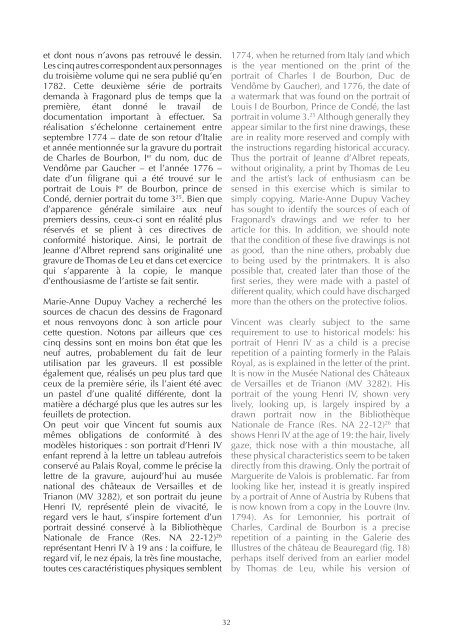Create successful ePaper yourself
Turn your PDF publications into a flip-book with our unique Google optimized e-Paper software.
et dont nous n’avons pas retrouvé le dessin.<br />
Les cinq autres correspondent aux personnages<br />
du troisième volume qui ne sera publié qu’en<br />
1782. Cette deuxième série de portraits<br />
demanda à <strong>Fragonard</strong> plus de temps que la<br />
première, étant donné le travail de<br />
documentation important à effectuer. Sa<br />
réalisation s’échelonne certainement entre<br />
septembre 1774 – date de son retour d’Italie<br />
et année mentionnée sur la gravure du portrait<br />
de Charles de Bourbon, I er du nom, duc de<br />
Vendôme par Gaucher – et l’année 1776 –<br />
date d’un filigrane qui a été trouvé sur le<br />
portrait de Louis I er de Bourbon, prince de<br />
Condé, dernier portrait du tome 3 25 . Bien que<br />
d’apparence générale similaire aux neuf<br />
premiers dessins, ceux-ci sont en réalité plus<br />
réservés et se plient à ces directives de<br />
conformité historique. Ainsi, le portrait de<br />
Jeanne d’Albret reprend sans originalité une<br />
gravure de Thomas de Leu et dans cet exercice<br />
qui s’apparente à la copie, le manque<br />
d’enthousiasme de l’artiste se fait sentir.<br />
Marie-Anne Dupuy Vachey a recherché les<br />
sources de chacun des dessins de <strong>Fragonard</strong><br />
et nous renvoyons donc à son article pour<br />
cette question. Notons par ailleurs que ces<br />
cinq dessins sont en moins bon état que les<br />
neuf autres, probablement du fait de leur<br />
utilisation par les graveurs. Il est possible<br />
également que, réalisés un peu plus tard que<br />
ceux de la première série, ils l’aient été avec<br />
un pastel d’une qualité différente, dont la<br />
matière a déchargé plus que les autres sur les<br />
feuillets de protection.<br />
On peut voir que Vincent fut soumis aux<br />
mêmes obligations de conformité à des<br />
modèles historiques : son portrait d’Henri IV<br />
enfant reprend à la lettre un tableau autrefois<br />
conservé au Palais Royal, comme le précise la<br />
lettre de la gravure, aujourd’hui au musée<br />
national des châteaux de Versailles et de<br />
Trianon (MV 3282), et son portrait du jeune<br />
Henri IV, représenté plein de vivacité, le<br />
regard vers le haut, s’inspire fortement d’un<br />
portrait dessiné conservé à la Bibliothèque<br />
Nationale de France (Res. NA 22-12) 26<br />
représentant Henri IV à 19 ans : la coiffure, le<br />
regard vif, le nez épais, la très fine moustache,<br />
toutes ces caractéristiques physiques semblent<br />
1774, when he returned from Italy (and which<br />
is the year mentioned on the print of the<br />
portrait of Charles I de Bourbon, Duc de<br />
Vendôme by Gaucher), and 1776, the date of<br />
a watermark that was found on the portrait of<br />
Louis I de Bourbon, Prince de Condé, the last<br />
portrait in volume 3. 25 Although generally they<br />
appear similar to the first nine drawings, these<br />
are in reality more reserved and comply with<br />
the instructions regarding historical accuracy.<br />
Thus the portrait of Jeanne d’Albret repeats,<br />
without originality, a print by Thomas de Leu<br />
and the artist’s lack of enthusiasm can be<br />
sensed in this exercise which is similar to<br />
simply copying. Marie-Anne Dupuy Vachey<br />
has sought to identify the sources of each of<br />
<strong>Fragonard</strong>’s drawings and we refer to her<br />
article for this. In addition, we should note<br />
that the condition of these five drawings is not<br />
as good, than the nine others, probably due<br />
to being used by the printmakers. It is also<br />
possible that, created later than those of the<br />
first series, they were made with a pastel of<br />
different quality, which could have discharged<br />
more than the others on the protective folios.<br />
Vincent was clearly subject to the same<br />
requirement to use to historical models: his<br />
portrait of Henri IV as a child is a precise<br />
repetition of a painting formerly in the Palais<br />
Royal, as is explained in the letter of the print.<br />
It is now in the Musée National des Châteaux<br />
de Versailles et de Trianon (MV 3282). His<br />
portrait of the young Henri IV, shown very<br />
lively, looking up, is largely inspired by a<br />
drawn portrait now in the Bibliothèque<br />
Nationale de France (Res. NA 22-12) 26 that<br />
shows Henri IV at the age of 19: the hair, lively<br />
gaze, thick nose with a thin moustache, all<br />
these physical characteristics seem to be taken<br />
directly from this drawing. Only the portrait of<br />
Marguerite de Valois is problematic. Far from<br />
looking like her, instead it is greatly inspired<br />
by a portrait of Anne of Austria by Rubens that<br />
is now known from a copy in the Louvre (Inv.<br />
1794). As for Lemonnier, his portrait of<br />
Charles, Cardinal de Bourbon is a precise<br />
repetition of a painting in the Galerie des<br />
Illustres of the château de Beauregard (fig. 18)<br />
perhaps itself derived from an earlier model<br />
by Thomas de Leu, while his version of<br />
32















